They say: "Better than ever."
We say: "Incrementally improved."
Razor-sharp. Scalpel-like. These and similar phrases tend to get thrown around when anyone describes Honda's CBR600RR supersport. Honda is proud of the CBR's reputation as both an accurate-handling canyon toy and an excellent all-around performer. The company is, understandably, eager to maintain that rep with the 2013 bike.
So rather than take any chances with a major overhaul, Honda has opted to put a finer edge on the existing 600RR package, much like it did with the CBR1000RR in 2012. In fact, the 600RR received many of the same changes as its big brother, including a Showa Big Piston Fork, split-spoke wheels, and similar EFI and Combined ABS (C-ABS) programming updates.
One area where the 600 received more attention than the 1000 is styling. For 2013, Honda totally altered the 600RR's image. Every body panel is new, redesigned with the intention of improving aerodynamics and providing a fresh look that more closely resembles Honda's MotoGP machines.
It's not just for appearances, either. Honda has some interesting claims regarding the 600's smoother skin, too. For one, it has 6.5 percent less drag, which presumably contributes to improved fuel economy, up from an estimated 40 mpg to 44. As I rode the 2013 CBR down the 101 freeway on my way to some fun canyons, I noticed a larger pocket of still air in the cockpit. Having ridden a friend's 2012 CBR600RR to the press launch in Simi Valley, CA, I was well acquainted with the previous bike's limited wind protection; move an inch or two to either side of the short windscreen and you're out in the breeze. Not so on the new bike, which has a slightly taller windscreen and wider fairing.
The 2013 machine is smoother, too, in terms of ride quality and throttle response. The new BPF and revised damping in the shock yield more compliance at the top of the suspension stroke, so small bumps and ripples are more readily absorbed, which makes the CBR a better bike on the freeway as well as in the twisties. A new ram-air intake and revised EFI and Intake Air Control Valve (IACV) tuning contribute a tad more midrange power and marginally improve throttle response at lower rpm and smaller throttle openings, an area where the 2012 bike suffered. Riding up Decker Canyon Road in first gear on the 2012 machine, I noticed quite a bit of abruptness when going from closed to open throttle and back at lower engine speeds. Riding the same road on the 2013 bike was more enjoyable thanks to smoother throttle response, though there is still room for improvement.
Spin the Honda up above 9000 rpm and most complaints vanish. Power picks up significantly as the revs rise to five figures, and throttle response becomes perfect. The CBR feels like your typical inline-four middleweight (perhaps because it is the archetypal middleweight), with adequate midrange power that builds rapidly as the tach needle approaches redline. Intake noise overpowers exhaust hum and vibes creep into the bars and pegs at higher rpm, but once you spin the CBR past 10,000 none of that matters. Light and nimble, powerful and sure-footed, the CBR600RR is still a force to be reckoned with in a tight California canyon, or any twisty road for that matter.
It would have been nice to see the CBR finally receive a slipper clutch, but in this economy-and with the 600 class still not generating huge sales-we should be grateful that his year's update included a complete facelift instead of just "bold new graphics." Honda is quick to admit that aesthetics are a top priority and play a big part in sales, thus the focus on a fresh look. For those of us who are more performance-oriented, the new CBR600RR is certainly a better bike than its predecessor. A tad cheaper, too. MSRP for the base model is $11,490, down $50 from last year. Adding Honda's excellent C-ABS adds $1000, while Repsol livery-available for the first time on the 600RR this year-costs an additional $500.
The CBR performed well on the street, but this was just the first part of the new machine's introduction. In a few weeks we'll be joining Honda at Chuckwalla Valley Raceway to experience the 2013 machine on the track. Check back later for our track evaluation and onboard video.
VERDICT 4 stars out of 5
Better than before, but with today's super-sophisticated supersports, it's going to take more than refinement to rise to the top.










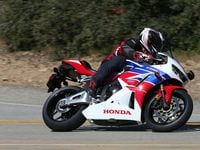
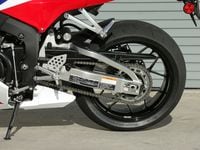
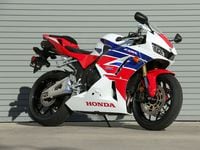
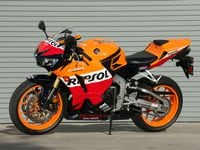
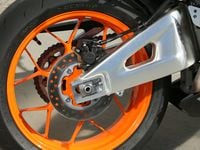


/cloudfront-us-east-1.images.arcpublishing.com/octane/S35YGSEMEZB4BLTDJTSZPF4GLA.jpg)
/cloudfront-us-east-1.images.arcpublishing.com/octane/5UOT6HPX2JFMRJAX6EH45AR4MQ.jpg)
/cloudfront-us-east-1.images.arcpublishing.com/octane/OKWOJWAKP5EP3OACCRRWPCIX2Q.jpg)
/cloudfront-us-east-1.images.arcpublishing.com/octane/2WF3SCE3NFBQXLDNJM7KMXA45E.jpg)
/cloudfront-us-east-1.images.arcpublishing.com/octane/G4MG6OUCJNBSHIS2MVVOTPX65E.jpg)
/cloudfront-us-east-1.images.arcpublishing.com/octane/IIGGWFOTOJGB7DB6DGBXCCMTDY.jpg)
/cloudfront-us-east-1.images.arcpublishing.com/octane/QSTCM6AVEZA5JJBUXNIQ3DSOF4.jpg)
/cloudfront-us-east-1.images.arcpublishing.com/octane/U4I7G625B5DMLF2DVIJDFZVV6M.jpg)
/cloudfront-us-east-1.images.arcpublishing.com/octane/B6XD6LS6IVCQPIU6HXDJSM3FHY.jpg)
/cloudfront-us-east-1.images.arcpublishing.com/octane/ICL63FEDDRDTTMINYICCEYGMDA.jpg)
/cloudfront-us-east-1.images.arcpublishing.com/octane/FCGZHQXRBZFLBAPC5SDIQLVF4I.jpg)
/cloudfront-us-east-1.images.arcpublishing.com/octane/WNOB6LDOIFFHJKPSVIWDYUGOPM.jpg)

/cloudfront-us-east-1.images.arcpublishing.com/octane/X33NU3E525ECRHXLNUJN2FTRKI.jpg)
/cloudfront-us-east-1.images.arcpublishing.com/octane/6KKT5NNL2JAVBOXMZYS5ZO76YA.jpg)
/cloudfront-us-east-1.images.arcpublishing.com/octane/J5RKG5O455GMPGQRF2OG6LRT7A.jpg)
/cloudfront-us-east-1.images.arcpublishing.com/octane/GX2CIZKQVRH2TATDM26KFG2DAE.jpg)
/cloudfront-us-east-1.images.arcpublishing.com/octane/ZWIDYSAKQZHD5BHREMQILXJCGM.jpg)
/cloudfront-us-east-1.images.arcpublishing.com/octane/CYUHJZCTSJCH3MRAQEIKXK7SCQ.jpg)
/cloudfront-us-east-1.images.arcpublishing.com/octane/LKOFINY56FCXJCANJ5M7ZDQUBY.jpg)
/cloudfront-us-east-1.images.arcpublishing.com/octane/4NBPDACMWJH63JQYJVK3QRBDZI.jpg)
/cloudfront-us-east-1.images.arcpublishing.com/octane/KKHQHRR3FJGX7H2IPU6RALMWG4.jpg)

/cloudfront-us-east-1.images.arcpublishing.com/octane/5IOFS5JAE5FOXMNA23ZRAVVYUU.jpg)